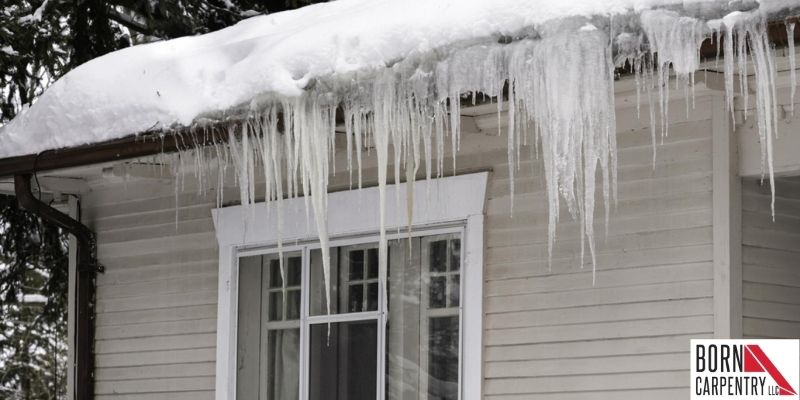Winter in Minnesota can ravage your roof as it deals with high amounts of rainfall, ice storms and snow during this brutal season. A roof must be strong enough to ensure the safety of both your family and your property. However, a typical Minnesota winter can test the integrity of your roof. Therefore, there is a need to be on the lookout for roof issues during this season. Identifying potential problems will help to avoid any damages due to the harsh climate.
Common Roof Issues In Minnesota Winters

The snowfall of winter may be beautiful and exciting. However, thanks to snow, your roof may develop issues during this period.
Some issues to watch out for in Minnesota winters may include…
1. Attic Condensation
Minnesota winters can cause damage to your home. If your house lacks proper ventilation, heated air will rise and may cause attic condensation making the walls of your attic wet. This moisture can remain in the attic for a long time and may result in mold growth up there.
To avoid attic condensation, ensure that your vents are unblocked and open. There must be enough open vents in your attic for heated air to escape outside, even during the coldest days of winter.
2. Leaks
Roof leaks are a common problem that a Minnesota winter can cause. Many of the roofs in Minnesota have metal flashes that are located at the joints. Flashings are the thin metal strips placed on the edges and ridges of your chimneys, roofs and skylights. These metal flashings help in preventing the seepage of water through the structure.
The aging process wears down the roof and loosens its shingles. The metal flashes can break when this happens, making your roof susceptible to leaks. Leaky flashings are a common issue during the winter. Minnesota winter snow and storms may loosen the flashings and even uplift them. This allows water to gain entry to your home. You can avoid leakage when you regularly maintain your roof flashings.
3. Snow
The winter season in Minnesota is characterized by heavy snow. Your roof invariably bears the weight of the snow. Although your roof may be built to withstand snow, its shingles and flashes can get damaged as a result of the accumulation of excess snow.
Additionally, your entire structure can be damaged when there is a disproportionate build-up of snow on one part of your roof. Furthermore, your shingles may get damaged if a wind gust causes heavy snow to pile up in areas where your roof meets the walls.
Sometimes, Minnesota winters can be so dramatic that ice melts during the daytime and freezes at night. This pattern can cause your roof’s shingles to loosen, expand or crack.
4. Icicles
The snow that melts and slides down your roof causes icicles. The temperature during the descent of the melted snow is typically cold. This cold temperature causes the water to freeze once again. Icicles are formed when the water freezes again. If left uncontrolled, icicles can spread to the entire roof.
Icicles can damage your roof and its shingles. To prevent this damage, you should insulate and ventilate your roof. You must also ensure that your gutters are free of leaves and debris, especially in the fall.
Removing snow and ice from the edges of your roof can help prevent icicle formation during the Minnesota winter months.
5. Ice Dams

Ice dams are formed by the accumulation of snow on top of your roof. The inner layer of the snow on your rooftop gets slightly melted by the warmth from the inside of your house. However, the snow does not completely melt because the inside of your house does not provide enough heat for that to happen. Nevertheless, the water from the slowly melting snow accumulates and refreezes to form ice dams. Moreover, the slightly melting snow may seep between shingles of your roof, causing damage as the water refreezes.
One way to address ice dams is by blowing cold air up to the ceiling. This will help prevent the melting of the ice and snow on your roof. Additionally, installing heat cables and or spraying warm water can help in safely removing ice dams.
6. Strong Winds
The extreme Minnesota winter is characterized by strong winds. Winter storms can damage flashing and peel back shingles or even pull off your roof. The high winds can also rip off gutters! Moisture is driven up into the vents of your roof when this happens, thus exposing your roof to harsh weather. The strong winds also make your roof susceptible to falling tree branches. While there is not much you can do to prevent wind damage, you should check your roof before the Minnesota winter starts. Ensure that your roof is not vulnerable by reinforcing all its structural components that will help to minimize wind damage. Generally, it helps to prepare for the arrival of the winter season and the strong winds that accompany it.
Conclusion
The harsh Minnesota winter weather can affect your roof because of its position on the top of your house. However, you must do all you can to keep your family and property safe from harsh outside weather. Need someone to professionally check your roof and prepare it for winter? Born Carpentry can do the job.






